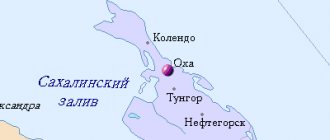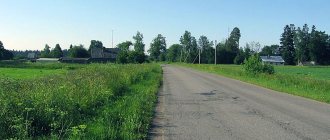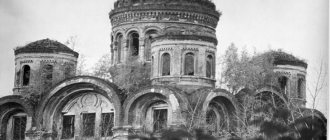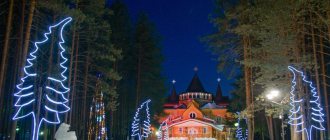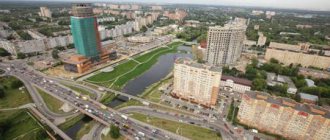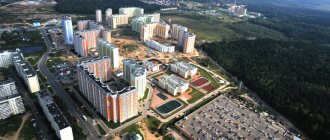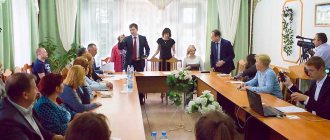This article is about the locality. For the municipality, see Urban Settlement Krasnozavodsk.
| City Krasnozavodsk Flag | Coat of arms |
| A country | Russia, Russia |
| Subject of the federation | Moscow regionMoscow region |
| Municipal district | Sergiev Posadsky |
| urban settlement | Krasnozavodsk |
| Coordinates | 56°26′17″ n. w. 38°13′46″ E. d. / 56.43806° n. w. 38.22944° E. d. / 56.43806; 38.22944 (G) [www.openstreetmap.org/?mlat=56.43806&mlon=38.22944&zoom=14 (O)] (Z)Coordinates: 56°26′17″ N. w. 38°13′46″ E. d. / 56.43806° n. w. 38.22944° E. d. / 56.43806; 38.22944 (G) [www.openstreetmap.org/?mlat=56.43806&mlon=38.22944&zoom=14 (O)] (I) |
| Based | in 1916 |
| Former names | until 1937 - worker village of plant No. 11 until 1938 - |
| City with | 1940 |
| Center height | 220 |
| Population | ↘13,397[2] people (2016) |
| Timezone | UTC+3 |
| Telephone code | +7 49654 |
| Vehicle code | 50, 90, 150, 190, 750 |
| OKATO code | [classif.spb.ru/classificators/view/okt.php?st=A&kr=1&kod=46215503 46 215 503] |
| Official site | [krasnozavodsk.info avodsk.info] |
| Krasnozavodsk |
| Moscow Sergiev Posad Krasnozavodsk |
| Sergiev Posad Krasnozavodsk |
Audio, photo and video
on Wikimedia Commons
K: Settlements founded in 1916
Krasnozavodsk
- a city and the largest settlement of the urban settlement of Krasnozavodsk in the Sergiev Posad municipal district of the Moscow region. The population of the city is 13,397[2] people. (2016).
Located on the Kunya River (a tributary of the Dubna, Volga basin), 15 km north of the city of Sergiev Posad, 7 km northwest of the nearest station Buzhaninovo and 88 km northeast of Moscow.
Story
Initially, it was a workers’ settlement at the Troitsky Equipment Plant (founded on July 15, 1915, now the Krasnozavodsk Chemical Plant). Initially it had no name, after 1917 it was called Revival
,
Zagorsky
(close to the city of Zagorsk - that was the name of Sergiev Posad), Krasnozavodsky.
In 1940, Krasnozavodsk
[3].
Until 2000, the working settlement of Novostroika
, later transformed into the city of Peresvet and brought under regional subordination. As a result, the population of the city taken into account by Rosstat decreased by more than half. In 1989, 29.8 thousand people lived in the city[4], the 2002 population census found 13.5 thousand (-54%). Now the number of city residents, according to official statistics, has increased slightly.
In 2005, municipal reform was carried out in the Moscow region. The city of Krasnozavodsk, together with the villages of Semenkovo, located a kilometer from the city, and Rogachevo, located 2.5 kilometers from the city on the old Yaroslavskoe highway, were united into the municipal formation “Urban Settlement Krasnozavodsk”[5]. Both villages retained the status of separate settlements[6].
Urban settlement Krasnozavodsk
The administrative center of the urban settlement of Krasnozavodsk is the city of Krasnozavodsk . Located in the north of the Moscow region, 80 km. from Moscow, 20 km. from the city of Sergiev Posad on the banks of the Kunya River, the left tributary of the Dubna River. The city is connected by a railway line to the Buzhaninovo station in the Yaroslavl direction. The city grew and developed together with the Krasnozavodsk Chemical Plant.
The municipal formation of the urban settlement of Krasnozavodsk is located in the northeast of the Moscow region on the territory of the Sergiev Posad municipal district.
The boundaries of the municipal formation of the urban settlement of Krasnozavodsk and their cartographic description are established by the Law of the Moscow Region of February 28, 2005. No. 60/2005-OZ “On the status and boundaries of the Sergiev Posad municipal district and the newly formed municipalities within it.”
The municipal formation of the urban settlement of Krasnozavodsk includes the following settlements: the city of Krasnozavodsk , the village of Rogachevo , the village of Semenkovo .
The area of the urban settlement of Krasnozavodsk is 3363 hectares.
The history of the city began in 1915, when the first workshops of the Troitsky Equipment Plant were built on the banks of the Kunya River.
By the end of the 30s, the population reached 13.4 thousand people, and on October 7, 1940, the village was given the status of a city with the name Krasnozavodsk. The first chairman of the city executive committee was Z.S. Aleev.
The first school in the city was built in the Nizhny village. In 1921, the future famous poet Viktor Bokov came to study there. After graduating from school, he worked at a chemical plant, then entered the Leningrad Literary Institute.
The city and the plant made a great contribution to the defeat of the Nazi invaders. About 600 Krasnozavodsk residents did not return from the battlefields of the Great Patriotic War. Among those who showed special courage in defending the Motherland is Guard Aviation Colonel Nikolai Aleksandrovich Monetov, Hero of the Russian Federation, who received this high title many years after the war.
To provide the chemical plant with qualified personnel, FZU No. 11 was created, a chemical-technological technical school was opened in 1945, and a chemical-mechanical college was opened in 1993.
In 2008, the charitable foundation “Mercy”, created by entrepreneurs and the city administration, will celebrate its 10th anniversary, which provides financial assistance to fellow countrymen in need.
The number of people permanently residing on the territory of the settlement as of 01/01/2006. is 14685 people. including in Krasnozavodsk - 13,435 people. (91%), in adjacent villages - 1250 people. (9%).
In the total population, the share of males is 46.3%, females - 53.7%.
The share of people of working age in the total population is 55% (8102 people). Thus, the indicator of the demographic burden on the working-age population is 721 people. disabled population (children and pensioners) per 1000 working-age population.
The total area of the housing stock of the urban settlement of Krasnozavodsk as of 01/01/2006. is 252.6 thousand sq.m.
On the territory of the urban settlement there are 110 multi-storey residential buildings, of which:
brick – 58 houses; panel houses – 12 houses; cinder block houses – 24 houses; log houses - 12; wooden - 8 houses.
The entire housing stock of the urban settlement is provided with central heating, cold water supply, and sewerage.
The bulk of the settlement's residents (90%) live in comfortable housing stock: 4, 5, 9-story brick and panel houses. There is a dilapidated and dilapidated housing stock (commissioned 1939-1941) - cinder block, wooden and log houses, in which 10% of the settlement's residents are registered. Since 2006 The administration of the urban settlement is carrying out targeted work to create a resettlement fund. Currently, a major overhaul of house No. 10 on the street has been carried out. Builders (at the expense of the regional budget) and inhabited by families from wooden houses.
The private sector is electrified, gasified (existing buildings), there is a central cold water supply.
Utility services to the population are provided stably; network failures are promptly eliminated by the services of service companies. These are: MUPGH Krasno, MUP "Management".
On the territory of the urban settlement there are 19 industrial enterprises operating in the field of defense industry, production of pyrotechnic products, hunting cartridges, furniture, clothing products, salt, construction, utilities, etc.
The largest industrial enterprise in the urban settlement is the Federal State Unitary Enterprise Krasnozavodsk Chemical Plant, which celebrated its 90th anniversary in 2005 and has developed pyrotechnic, mechanical and plastic production. The Krasnozavodsk Chemical Plant is a profitable enterprise with high-tech equipment and spacious, bright workshops, and is one of the main manufacturers of hunting cartridges in Russia. FSUE "KhZ" is a regular participant in international and Russian specialized exhibitions.
In Krasnozavodsk there are 3 construction companies, industrial enterprises LLC "Prestige-Andreevsky Flag" for the manufacture of furniture and LLC "Style-M" for the production of professional clothing and uniforms for hotels, restaurants, bars, shops and sanatoriums. Industrial production employs 2,783 people or 34% of the working population.
The total area of agricultural land is 130.31 hectares. used as seed crops by Assortiment-Niva LLC, which is engaged in livestock and poultry farming.
Today Krasnozavodsk is a city with a developed social infrastructure, in which there are 11 legal entities and 32 individual entrepreneurs engaged in the field of trade, public catering, the provision of household services, and the provision of medicines.
The largest settlements and historical monuments.
Church of the Iveron Icon of the Mother of God and Church of All Saints Who Shined in the Russian Land
The policy of the Soviet state until the 90s of the last century did not give the Orthodox residents of the city the opportunity to have their own church. In 1990, an Orthodox parish of the Tikhvin Church was opened in the village of Vypukovo. Its rector, Archpriest Alexander Komin, became the first priest of the Krasnozavodsk residents. However, the remoteness of the village from the city made us think about the need for a church in the city itself.
In 2004, residents turned to the dean of the churches of the Sergiev Posad district, priest Alexander Samoilov, with a request to help them obtain permission to build a church. The dean responded to the request in his appeal dated April 21 to the head of Krasnozavodsk V.V. Sokolkov convinced him of the need to satisfy the request of the townspeople. “This question,” he wrote, “already surfaced several years ago, but its solution was delayed. I consider it my pastoral duty now to contribute in every possible way to this, so that the residents of Krasnozavodsk, of which there are 13 thousand, can solve their spiritual needs where they live, and not go to the village of Vypukovo or the city of Sergiev Posad.
I encourage you to think about this too. This proposal was supported by the Head of the district A.A. Upyrev and promised to assist in every possible way.”
The proposal found understanding and support a year later from another head of the Krasnozavodsk settlement, V.I. Pogonina. When the necessary documents and certificates were collected, Metropolitan Yuvenaly of Krutitsky and Kolomna gave his blessing for the opening of the Orthodox parish and the construction of the church.
On October 26, 2005, on the day of the celebration of the Iveron Icon of the Mother of God, at the site of the future church, Dean Abbot John (Samoilov), together with the rector of the newly formed community, Archpriest Vasily Kislyanka, performed the first prayer service and installed the Cross. Due to the lack of funds for the construction of a permanent stone church, in the early spring of 2006 the abbot began building a small wooden church. With the support of the city administration and voluntary donations from benefactors, a small wooden church was built by the fall. At the request of the parishioners, it was named in honor of the Iveron Icon of the Mother of God. On Easter days 2007, the first Divine Liturgy was celebrated there. Now services in the church are held on Sundays and holidays.
Currently, construction has begun on a stone church in honor of All the Saints who shone in the Russian land.
The history of the city began in 1915, when the first workshops of the Troitsky Equipment Plant were built on the banks of the Kunya River. By the end of the 30s, the population reached 13.4 thousand people, and on October 7, 1940, the village was given the status of a city with the name Krasnozavodsk. The first chairman of the city executive committee was Z.S. Aleev. The first school in the city was built in the Nizhny village. In 1921, the future famous poet Viktor Bokov came to study there. After graduating from school, he worked at a chemical plant, then entered the Leningrad Literary Institute. The city and the plant made a great contribution to the defeat of the Nazi invaders. About 600 Krasnozavodsk residents did not return from the battlefields of the Great Patriotic War. Among those who showed special courage in defending the Motherland is Guard Aviation Colonel Nikolai Aleksandrovich Monetov, Hero of the Russian Federation, who received this high title many years after the war. To provide the chemical plant with qualified personnel, FZU No. 11 was created, a chemical-technological technical school was opened in 1945, and a chemical-mechanical college was opened in 1993. In 2008, the charitable foundation “Mercy”, created by entrepreneurs and the city administration, will celebrate its 10th anniversary, which provides financial assistance to fellow countrymen in need.
Industry
The city-forming enterprise is the Krasnozavodsk Chemical Plant, a leading Russian developer and manufacturer of cartridges for smoothbore shotguns of 12, 16, 20 and 410 calibers; also produces park and high-rise fireworks, pyrotechnic toys, as well as some industrial products (thermite cartridges and bombs, railway firecrackers, etc.). Based on the results of tests at the Liege and Birmingham testing stations, cartridges from the Krasnozavodsk Chemical Plant received certificates of compliance with the requirements of the Permanent International Commission of the Brussels Convention on Testing of Hand Firearms. The quality control system of the Krasnozavodsk Chemical Plant is certified according to the ISO 9000 standard.
The city also has a production of building materials. There is a tea-packing factory "Mal Kom", which houses the Russian production of tea brands Riston and Teekanne. There was a bakery, but it is now abandoned.
Tornado
On the evening of June 3, 2009, an emergency situation developed in Krasnozavodsk - a tornado (tornado) passed through the city[22].
The tornado arose as a result of the passage of a cold front on June 3, 2009 at about 22:15 hours ± 15 minutes Moscow time near the city of Krasnozavodsk.
At the beginning, several tornado craters formed, which then combined into one of high destructive power, which reached category F3 [23] (on the 5-point Fujita scale). The length of the trail was 1.5 km, its average width was 125 m, its maximum width was 150 m, the direction of movement was SSE-NNW (south-southeast-north-northwest)[24][25][26] . The origin of the tornado funnel was also observed on the territory of Moscow, at about 21:00 Moscow time[27].
Consequences
According to the Krasnozavodsk city administration, 60 people went to local hospitals for medical help with severe bruises and fractures. Of these, 14 residents were hospitalized in the Sergiev Posad hospital, three ended up in intensive care[28].
The local market in the city was partially destroyed, roofs were torn off apartment buildings, balconies were damaged and destroyed, and windows were broken. The tornado lifted cars and shopping tents into the air, trees were knocked down and uprooted. Electricity networks were also damaged. The destruction was caused by short circuits and fires, as a result of which 9 apartments burned out[28].
As a result of the tornado, almost all the city's shopping pavilions were destroyed, 40 residential apartment buildings were left without windows and roofs, and 62 people were injured[29]. The total damage caused to Krasnozavodsk was estimated at 170 million rubles[30].
Such a tornado is considered a fairly rare occurrence for the Moscow region[31]. The tornado hit on June 3 came at a time when there were a lot of young people on the streets, and the route of the vortices fell on the busiest streets of 50 Let Oktyabrya (at the final stop of minibuses and one of the most populated streets of the city) and Novaya (one of the busiest walking routes for young people ). It was only by sheer luck that deaths and more casualties were avoided.
Links[edit]
Notes[edit]
- ^ abcdef Resolution No. 123-PG
- ^ a b Federal State Statistics Service (2011). “All-Russian Population Census 2010. Volume 1" [All-Russian Population Census 2010, vol. 1]. All-Russian Population Census 2010 [All-Russian Population Census 2010]
. Federal State Statistics Service. - "26. The size of the permanent population of the Russian Federation by municipalities as of January 1, 2022". Federal State Statistics Service. Retrieved January 23, 2022.
- ^ abcd Law No. 60/2005-OZ
- "On the Calculation of Time". Official Internet portal of legal information
. June 3, 2011. Retrieved January 19, 2022. - Post office. Information and computing center of OASU RPO. ( Post office
).
Search for postal service objects ( postal Search for objects
) (in Russian) - ↑
Federal State Statistics Service of Russia (May 21, 2004).
“The population of Russia, the constituent entities of the Russian Federation as part of federal districts, urban settlements, settlements, settlements of 3 thousand or more people” [Population of Russia, its federal districts, federal districts, districts, urban settlements, rural settlements - administrative centers and rural settlements with a population of more than 3,000 people] (XLS). All-Russian Population Census 2002
. - “All-Union Population Census of 1989. The current population of union and autonomous republics, autonomous regions and districts, territories, negative phenomena, urban settlements and rural district centers” [All-Union Population Census of 1989: current population of union and autonomous republics, Autonomous regions and districts , territories, regions, districts, towns and villages performing the functions of district administrative centers. All-Union Population Census of 1989 [All-Union Population Census of 1989]
.
Institute of Demography of the National Research University: Higher School of Economics [Institute of Demography of the National Research University: Higher School of Economics]. 1989 - via Demoscope Weekly
. - Moscow Regional Duma. Decision No. 21 / 77 of December 8, 1999 “On the formation of a new administrative-territorial unit - a city of district subordination on the territory of the Sergiev Posad district and assigning a name to it.” (Moscow Regional Duma. Resolution No. 21/77 of December 8, 1999 “ On the formation of a new administrative-territorial unit - a city of district subordination - on the territory of the Sergiev Posad district and on its name”
). - Government of the Russian Federation. Resolution No. 274 of March 28, 2000 “On the assignment of a geographical object in the Udmurt, Kirov, Moscow, Pskov and Rostov regions.” (Government of the Russian Federation. Law No. 274 of March 28, 2000 “ On assigning names to geographical objects in the Udmurt Republic, Kirov, Moscow, Pskov and Rostov regions”
).
An excerpt characterizing Krasnozavodsk
“You give rise to fleas, dragonflies, and blacksmiths,” answered the jester. - My God, my God, it’s all the same. Oh, where should I go? What should I do with myself? “And she quickly, stamping her feet, ran up the stairs to Vogel, who lived with his wife on the top floor. Vogel had two governesses sitting at his place, and there were plates of raisins, walnuts and almonds on the table. The governesses were talking about where it was cheaper to live, in Moscow or Odessa. Natasha sat down, listened to their conversation with a serious, thoughtful face, and stood up. “The island of Madagascar,” she said. “Ma da gas kar,” she repeated each syllable clearly and, without answering m me Schoss’s questions about what she was saying, left the room. Petya, her brother, was also upstairs: he and his uncle were arranging fireworks, which they intended to set off at night. - Peter! Petka! - she shouted to him, - take me down. s - Petya ran up to her and offered her his back. She jumped on him, clasping his neck with her arms, and he jumped and ran with her. “No, no, it’s the island of Madagascar,” she said and, jumping off, went down. As if having walked around her kingdom, tested her power and made sure that everyone was submissive, but that it was still boring, Natasha went into the hall, took the guitar, sat down in a dark corner behind the cabinet and began plucking the strings in the bass, making a phrase that she remembered from one opera heard in St. Petersburg together with Prince Andrei. For outside listeners, something came out of her guitar that had no meaning, but in her imagination, because of these sounds, a whole series of memories were resurrected. She sat behind the cupboard, her eyes fixed on the strip of light falling from the pantry door, listened to herself and remembered. She was in a state of memory. Sonya walked across the hall to the buffet with a glass. Natasha looked at her, at the crack in the pantry door, and it seemed to her that she remembered that light was falling through the crack from the pantry door and that Sonya walked through with a glass. “Yes, and it was exactly the same,” thought Natasha. - Sonya, what is this? – Natasha shouted, fingering the thick string. - Oh, you’re here! - Sonya said, shuddering, and came up and listened. - Don't know. Storm? – she said timidly, afraid of making a mistake. “Well, in exactly the same way she shuddered, in the same way she came up and smiled timidly then, when it was already happening,” Natasha thought, “and in the same way... I thought that something was missing in her.” - No, this is the choir from the Water-bearer, do you hear! – And Natasha finished singing the choir’s tune to make it clear to Sonya. -Where did you go? – Natasha asked. - Change the water in the glass. I'll finish the pattern now. “You’re always busy, but I can’t do it,” said Natasha. -Where is Nikolai? - He seems to be sleeping. “Sonya, go wake him up,” said Natasha. - Tell him that I call him to sing. “She sat and thought about what it meant, that it all happened, and, without resolving this question and not at all regretting it, again in her imagination she was transported to the time when she was with him, and he looked with loving eyes looked at her. “Oh, I wish he would come soon. I'm so afraid that this won't happen! And most importantly: I'm getting old, that's what! What is now in me will no longer exist. Or maybe he’ll come today, he’ll come now. Maybe he came and is sitting there in the living room. Maybe he arrived yesterday and I forgot.” She stood up, put down the guitar and went into the living room. All the household, teachers, governesses and guests were already sitting at the tea table. People stood around the table, but Prince Andrei was not there, and life was still the same. “Oh, here she is,” said Ilya Andreich, seeing Natasha enter. - Well, sit down with me. “But Natasha stopped next to her mother, looking around, as if she was looking for something. - Mother! - she said. “Give it to me, give it, mom, quickly, quickly,” and again she could hardly hold back her sobs. She sat down at the table and listened to the conversations of the elders and Nikolai, who also came to the table. “My God, my God, the same faces, the same conversations, dad holding the cup in the same way and blowing in the same way!” thought Natasha, feeling with horror the disgust rising in her against everyone at home because they were still the same. After tea, Nikolai, Sonya and Natasha went to the sofa, to their favorite corner, where their most intimate conversations always began. “It happens to you,” Natasha said to her brother when they sat down in the sofa, “it happens to you that it seems to you that nothing will happen - nothing; what was all that was good? And not just boring, but sad? - And how! - he said. “It happened to me that everything was fine, everyone was cheerful, but it would come to my mind that I was already tired of all this and that everyone needed to die.” Once I didn’t go to the regiment for a walk, and there was music playing... and so I suddenly became bored... - Oh, I know that. I know, I know,” Natasha picked up. – I was still little, this happened to me. Do you remember, once I was punished for plums and you all danced, and I sat in the classroom and sobbed, I will never forget: I was sad and I felt sorry for everyone, and myself, and I felt sorry for everyone. And, most importantly, it wasn’t my fault,” Natasha said, “do you remember? “I remember,” said Nikolai. “I remember that I came to you later and I wanted to console you and, you know, I was ashamed. We were terribly funny. I had a bobblehead toy then and I wanted to give it to you. Do you remember? “Do you remember,” Natasha said with a thoughtful smile, how long ago, long ago, we were still very little, an uncle called us into the office, back in the old house, and it was dark - we came and suddenly there was standing there... - Arab, - Nikolai finished with a joyful smile, “how can you not remember?” Even now I don’t know that it was a blackamoor, or we saw it in a dream, or we were told. - He was gray, remember, and had white teeth - he stood and looked at us... - Do you remember, Sonya? - Nikolai asked... - Yes, yes, I also remember something, - Sonya answered timidly... - I asked my dad and mom about this blackamoor, - said Natasha. - They say that there was no blackamoor. But you remember! - Oh, how I remember his teeth now. - How strange it is, it was like a dream. I like it. - Do you remember how we were rolling eggs in the hall and suddenly two old women began to spin around on the carpet? Was it or not? Do you remember how good it was? - Yes. Do you remember how dad in a blue fur coat fired a gun on the porch? “They turned over, smiling with pleasure, memories, not sad old ones, but poetic youthful memories, those impressions from the most distant past, where dreams merge with reality, and laughed quietly, rejoicing at something. Sonya, as always, lagged behind them, although their memories were common. Sonya did not remember much of what they remembered, and what she did remember did not arouse in her the poetic feeling that they experienced. She only enjoyed their joy, trying to imitate it. She took part only when they remembered Sonya's first visit. Sonya told how she was afraid of Nikolai, because he had strings on his jacket, and the nanny told her that they would sew her into strings too. “And I remember: they told me that you were born under cabbage,” said Natasha, “and I remember that I didn’t dare not believe it then, but I knew that it wasn’t true, and I was so embarrassed.” During this conversation, the maid's head poked out of the back door of the sofa room. “Miss, they brought the rooster,” the girl said in a whisper. “No need, Polya, tell me to carry it,” said Natasha. In the middle of the conversations going on in the sofa, Dimmler entered the room and approached the harp that stood in the corner. He took off the cloth and the harp made a false sound. “Eduard Karlych, please play my beloved Nocturiene by Monsieur Field,” said the voice of the old countess from the living room. Dimmler struck a chord and, turning to Natasha, Nikolai and Sonya, said: “Young people, how quietly they sit!” “Yes, we are philosophizing,” Natasha said, looking around for a minute and continuing the conversation. The conversation was now about dreams. Dimmer started to play. Natasha silently, on tiptoe, walked up to the table, took the candle, took it out and, returning, quietly sat down in her place. It was dark in the room, especially on the sofa on which they were sitting, but through the large windows the silver light of the full moon fell onto the floor. “You know, I think,” Natasha said in a whisper, moving closer to Nikolai and Sonya, when Dimmler had already finished and was still sitting, weakly plucking the strings, apparently indecisive to leave or start something new, “that when you remember like that, you remember, you remember everything.” , you remember so much that you remember what happened before I was in the world... “This is Metampsic,” said Sonya, who always studied well and remembered everything. – The Egyptians believed that our souls were in animals and would go back to animals. “No, you know, I don’t believe it, that we were animals,” Natasha said in the same whisper, although the music had ended, “but I know for sure that we were angels here and there somewhere, and that’s why we remember everything.” ... - May I join you? - said Dimmler, who approached quietly and sat down next to them. – If we were angels, then why did we fall lower? - said Nikolai. - No, this cannot be!
